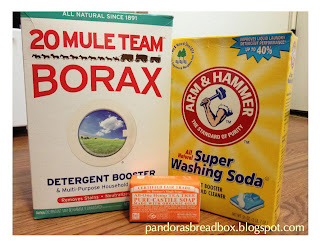
This is another thing that had been on my to-do list for a very long time. I found a recipe from The Eco-Friendly Family for a dishwasher detergent that doesn't contain Borax. Although I use Borax in my laundry detergent, there is a bit of a controversy surrounding it. Borax is listed as being hazardous but only if ingested in large amounts, so I feel more comfortable eliminating it altogether from food and eating surfaces.
To preface the recipe, let me tell you about my dishwasher. When we first moved into our current town home, the dishwasher quit working after 2 wash cycles. I called the landlords and twice they sent someone over to fix it to no avail. They decided to just install a new one. My dishwasher is a little over a year old and it never really cleaned dishes. You have to excessively pre rinse so that it doesn't throw food chunks all over your other dishes. I have to be careful where certain things are placed in the dishwasher or they won't get clean. In other words, we have a bottom of the barrel quality dishwasher. Oh yeah, and hard water on top of that. Some days I felt like I might've been better off just hand washing everything. I was using liquid Cascade for years and it did an alright job but it would leave these weird white spots all over things. Even with Jet Dry, and I eventually switched that out for white vinegar. I don't know if it was soap goo or hard water minerals or what. All I know is I didn't want whatever that was in my food.
I already had most of the ingredients for the detergent except the sea salt and the Lemi-Shine. I do a lot of cleaning with baking soda and I had the washing soda from making laundry detergent. The great thing about the Lemi-Shine and salt is that they soften your water if it's hard. After a week's worth of washes, not once had there been any weird white spots on anything. Sold! It does a good job at getting everything clean, too. Everything should be easily available at your local grocery or big box store.
 12 oz container of Lemi-Shine (found with the dish detergents)
12 oz container of Lemi-Shine (found with the dish detergents)1 1/2 cups washing soda
1/2 cup baking soda
1/2 cup sea salt
Mix it all together and store in a dry container. Use 2 tablespoons per load. I like to use white vinegar in the Jet Dry dispenser.


































